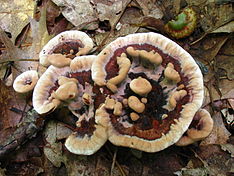Hydnellum scrobiculatum
| Hydnellum scrobiculatum | |
|---|---|
 |
|
| Scientific classification | |
| Kingdom: | Fungi |
| Division: | Basidiomycota |
| Class: | Agaricomycetes |
| Order: | Thelephorales |
| Family: | Bankeraceae |
| Genus: | Hydnellum |
| Species: | H. scrobiculatum |
| Binomial name | |
|
Hydnellum scrobiculatum (Fr.) P.Karst. (1879) |
|
| Synonyms | |
|
|
Hydnellum scrobiculatum, commonly known as the ridged tooth, is a tooth fungus in the family Bankeraceae. Widely distributed in the Northern Hemisphere, it is found in Asia, Europe, and North America.
The fungus was first described as a species of Hydnum by Elias Magnus Fries in his 1815 work Observationes mycologicae.Petter Karsten transferred it to the genus Hydnellum in 1879. Canadian mycologist Kenneth A. Harrison published the variety H. scrobiculatum var. zonatum as a new combination in 1961, but this is now considered to be synonymous with Hydnellum concrescens.Common names given to the species include "pitted corky spine fungus", and the British Mycological Society recommended name "ridged tooth".
Fruitbodies of Hydnellum scrobiculatum have centrally depressed caps measuring 2–6 cm (0.8–2.4 in) in diameter. These caps can fuse together to form concrescent fruitbodies. The caps have wavy edges, and an initially felty surface that becomes scaly with age. Young fruit bodies are white, then pinkish-brown, then purplish brown, sometimes with white margins. Fruitbodies can become shiny in age.
The spines on the cap underside are up to 4 mm long. They are initially white, but become purplish brown in maturity. The spines are decurrent—they run down the length of the stipe. The stipe, which is roughly the same color as the cap, measures 2–3 cm (0.8–1.2 in) long by 1–1.5 cm (0.4–0.6 in) thick.Mycelium at the base of the stipe envelops and grows around forest litter. The flesh smells mealy (similar to freshly ground flour). The edibility of the fruitbody is unknown, but in general Hydnellum species are too acrid and woody to be palatable.
...
Wikipedia
